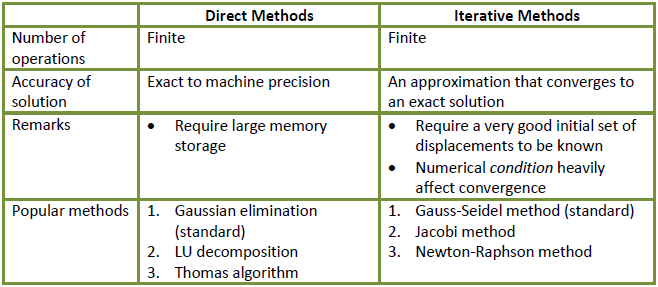- Derive local stiffness matrices (k)
- Assemble k into K, the global stiffness matrix
June 30, 2013
Steps to Derive k and Assemble into K
Figure 1 is a flowchart illustrating the sequence for computing the stiffness matrix of a simple problem (the concept is similar to more complex problems). Computing the stiffness matrix involves two main steps:
June 22, 2013
Matrix Methods: Direct vs. Iterative
Direct vs. Iterative methods
The two approaches available for solving global stiffness matrix (K) in FEM are:

The two approaches available for solving global stiffness matrix (K) in FEM are:

Implications on FEA solver
- For linear simulation e.g. KU = f , Gaussian elimination can be applied directly
- For nonlinear simulation e.g. K(u)U=f, stiffness is dependent on displacements (u). Therefore an iterative method must be used.
June 06, 2013
What is Meshing?
Meshing involves:
- discretisation of a continuum into finite number of elements
- defining element type (determined by shape functions)
- nodal connectivity
 |
| A finite element mesh adapted from Dr TE Kendon's research page |
Traditionally, meshing is performed by human user. Automatic meshing technologies are becoming more readily available and user friendly in FEA pre-processors as the competition in the FEA software market gets fierce than ever.
Also read
Subscribe to:
Posts (Atom)